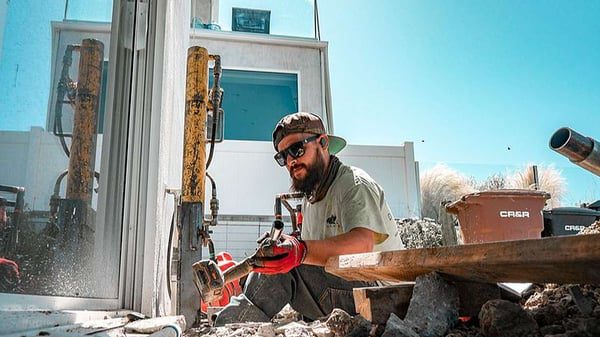Do you live in LA, San Diego, or Phoenix with big, tall skyscrapers jutting up towards space or other large commercial buildings? Office buildings, warehouses, hotels, restaurants, and retail buildings all fall under the category of commercial buildings. Occasionally, these buildings require extra structural support via shoring. If you want to learn how the shoring process works for commercial and industrial buildings, this article is for you.
We here at Dalinghaus Construction Inc. have been in the foundation repair industry since 2015 and hold over 100 years of combined experience shoring up commercial buildings across Southern California and Arizona.
In this article, you will learn the most common reason why commercial buildings require shoring and how the shoring process works involving push and helical piers.

Why Do Some Industrial Buildings Require Shoring?
Shoring commercial buildings in the city is particularly prevalent when structure requires any type of repair that requires extensive excavation. As large amounts of soil are removed, the buildings around the project structure lose the soil structural support.
In order to ensure the buildings nearest to the excavation site are not damaged and retain their structural integrity, shoring is utilized as a precautionary measure.
What is shoring?Shoring is the process of supporting a building or structure and is utilized during repairs, modifications, or when a building is in danger of structural failure. The phrase “shore up” is taken from the word “shore”, signifying to “prop” timber against a building to provide additional structural reinforcement. |
Shoring with Steel Pier Systems: Push Piers, Helical Piers, & Helical Tiebacks
Commercial shoring is often considered a temporary measure; however, it doesn’t have to be. Shoring with steel pier systems provides permanent support. Steel pier systems include push piers, helical piers, and helical tiebacks. These steel pier systems act as an underground stilt support structure, lodging into bedrock and/or competent, load-bearing soil.
Steel pier systems are:
- Comprised of galvanized steel to impede rust/oxidization
- Constructed with maximum load capacities ranging from 68,000 to 74,000 pounds
- Driven to an average depth of 25 to 30 feet
- Comprised of three main components: remedial bracket, starter, & extensions
Steel pier system shoring will not only provide adequate support during an extensive renovation of a neighboring building but provide long-lasting reinforcement against expansive soil (the number one cause of structure settlement).
To learn more about expansive soil, read our article: What is Expansive Soil & How Does it Cause Foundation Settlement?
Is Steel Pier Shoring Right for Your Commercial Building?
In this article, you learned the definition of shoring, the primary reason why commercial buildings require industrial shoring, and how steel pier systems provide permanent support against weak, non-load-bearing soil.
Dalinghaus Construction Inc. provides a number of foundation repair solutions, from steel pier systems, polyurethane deep injection, and carbon fiber crack repair, to post and pad replacement. We believe educated homeowners and business owners make the best decisions.
If you live in Southern California or Arizona and your commercial building needs to be shored up, click on the link below for a free consultation.






